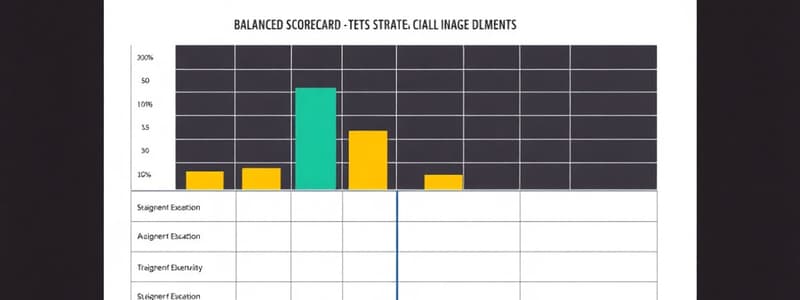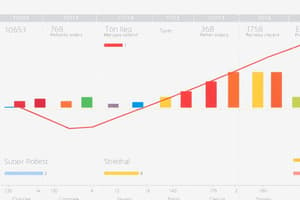Podcast
Questions and Answers
What primary deficiency is addressed by the Balanced Scorecard?
What primary deficiency is addressed by the Balanced Scorecard?
- Financial measures alone focus too heavily on stakeholder satisfaction.
- Financial measures alone are insufficient for developing long-term strategy.
- Financial measures alone cannot inform organizational culture.
- Financial measures alone do not answer key strategic questions. (correct)
What are the critical components of a balanced scorecard?
What are the critical components of a balanced scorecard?
- Indicators, Goals, Strategies, Performance
- Measurements, Techniques, Strategies, Outcomes
- Metrics, Objectives, Tactics, Results
- Measurements, Targets, Initiatives, Relationships (correct)
What aspect of organizational performance does the strategy map primarily emphasize?
What aspect of organizational performance does the strategy map primarily emphasize?
- Linking financial goals with employee satisfaction.
- Aligning departmental budgets with operational activities.
- Simplifying the reporting process for performance metrics.
- Creating a cause-and-effect relationship among strategic objectives. (correct)
Which year marked the shift in Balanced Scorecard focus to enterprise-wide strategic management?
Which year marked the shift in Balanced Scorecard focus to enterprise-wide strategic management?
What is the significance of linking goals to objectives and measurements in a Balanced Scorecard?
What is the significance of linking goals to objectives and measurements in a Balanced Scorecard?
What is the primary purpose of a balanced scorecard in an organization?
What is the primary purpose of a balanced scorecard in an organization?
Which of the following statements accurately reflects the evolution of balanced scorecards over the years?
Which of the following statements accurately reflects the evolution of balanced scorecards over the years?
In a balanced scorecard, what is meant by 'line of sight'?
In a balanced scorecard, what is meant by 'line of sight'?
What is indicated by the four perspectives of performance in a strategy map?
What is indicated by the four perspectives of performance in a strategy map?
Which statement best describes the relationship among goals, objectives, measurements, and targets within a balanced scorecard?
Which statement best describes the relationship among goals, objectives, measurements, and targets within a balanced scorecard?
Flashcards
Limitations of financial metrics
Limitations of financial metrics
Financial metrics alone are insufficient to answer key questions about a company's strategy, like its current position, future direction, and execution plan.
Balanced Scorecard evolution
Balanced Scorecard evolution
The Balanced Scorecard evolved through three stages: (1) focusing on financial measures and reporting, (2) emphasizing alignment and communication, and (3) becoming an enterprise-wide strategic management system.
Strategy-action gap
Strategy-action gap
The Balanced Scorecard bridges the gap between strategy development and execution by providing a framework for translating strategic goals into actionable measures.
Four perspectives of the Balanced Scorecard
Four perspectives of the Balanced Scorecard
Signup and view all the flashcards
Cause-and-effect relationships in Balanced Scorecard
Cause-and-effect relationships in Balanced Scorecard
Signup and view all the flashcards
Why is the Balanced Scorecard needed?
Why is the Balanced Scorecard needed?
Signup and view all the flashcards
How has the Balanced Scorecard evolved?
How has the Balanced Scorecard evolved?
Signup and view all the flashcards
What is the link between strategy and action in the Balanced Scorecard?
What is the link between strategy and action in the Balanced Scorecard?
Signup and view all the flashcards
What are the four perspectives of the Balanced Scorecard?
What are the four perspectives of the Balanced Scorecard?
Signup and view all the flashcards
How does the Balanced Scorecard show cause and effect?
How does the Balanced Scorecard show cause and effect?
Signup and view all the flashcards
Study Notes
Origin of Balanced Scorecards
- Financial measures alone are insufficient to answer crucial strategic questions: "Where are we?", "Where are we going?", and "How will we get there?".
Balanced Scorecard History
- Measures and reporting were emphasized in 1992.
- Alignment and communication were key in 1996.
- Enterprise-wide strategic management was addressed in 2000.
- Articles in Harvard Business Review, such as "The Balanced Scorecard," "Putting the Balanced Scorecard to Work," and "Using the Balanced Scorecard as a Strategic Management System," furthered the concept in the 1990s.
Current Usage
- Approximately 70% of Fortune 1,000 companies use the Balanced Scorecard for performance management.
- It's also a tool for strategy development and testing.
- Widely used in the public sector.
Strategy and Action Gap
- The Balanced Scorecard bridges the strategy-action gap by creating cause-and-effect relationships within an organization.
- Strategy is a series of cause-and-effect relationships.
- It provides a clear link from strategic objectives to operational activities, ensuring focus on the right things.
Basic Principles of Balanced Scorecard
- The strategy is plotted out on a Strategy Map, encompassing four performance perspectives.
- The scorecards must display cause-and-effect relationships between strategic objectives across these four perspectives on the Strategy Map.
- Essential components include clearly defined measurements, targets, and initiatives.
- A structured, interconnected model is crucial: Goals are linked to Objectives, Objectives to Measurements, and Measurements to Targets.
- The scorecard needs to function as a tightly integrated model to execute the strategy effectively.
Studying That Suits You
Use AI to generate personalized quizzes and flashcards to suit your learning preferences.




